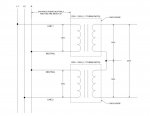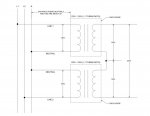mmontoya
Member
- Location
- Bayonne, NJ, US
I want to connect two separate 120V (7.5KVA) isolation transformers, tie the secondaries, but not the primaries. The input is 120V for each primary, with the goal to have 240/120V on the output. I guess you can call the primaries of the two transformers as floating and/or isolated primaries. I tried searching all of the world wide web for this type of application, but it seems very uncommon. Typically, the primaries are connected right at the transformers. The logic I had was that the transformers are technically connected at the neutrals upstream at a terminal block, but that distance is about 50 feet. To clarify my intention, I drew what the circuit would like below (link is below as well). I want to know if this is possible, what should I do to make this works, NEC concerns such as following 450.7 Parallel Operation, and what issues should I look out for. Also, how would the output look if the 2nd transformer below had Line 2 and the Neutral switched on the primary?
I did see issues online about non-matching polarity, insufficent insulation in the transformers, ease of mis-wiring, equal impedance's and ratios, and others. All help is appreciated.


https://i.stack.imgur.com/dnxiv.jpg
I did see issues online about non-matching polarity, insufficent insulation in the transformers, ease of mis-wiring, equal impedance's and ratios, and others. All help is appreciated.


https://i.stack.imgur.com/dnxiv.jpg

